Enhance LoRa Communication with a LoRa Antenna!
LoRa Communications and their unique use in long range, low power wireless transmission have cemented their popularity in Industrial IoT. On one hand, LoRaWAN networks, gateways & nodes are often the focus of discussion since they enable new possibilities for large scale IoT applications. However, did you know that there is a less spoken-about component of LR communication that can affordably yet vastly improve your existing LR systems? That’s right – it’s time to talk about LR Antennas.
This article will cover the following content and more!
- Recap: What is LoRa & LoRaWAN?
- What does a LoRa Antenna do in LoRa Communication?
- Long Range Applications with LoRa & LoRaWAN
- Getting Started with LoRa: Product Recommendations
- Tutorial: How to Set Up LoRa Communication on Arduino or Raspberry Pi!
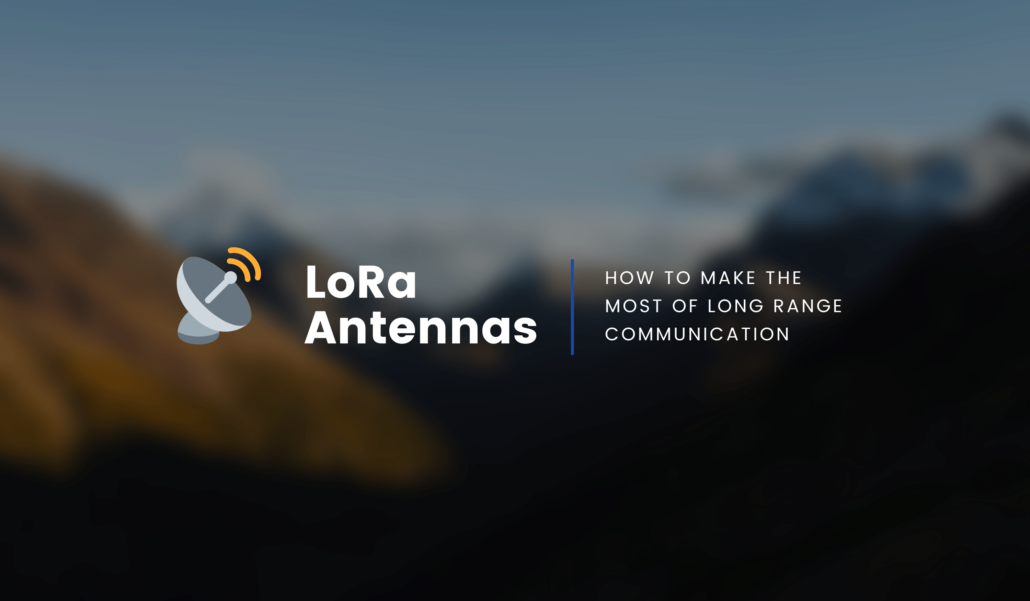
What is LoRa & LoRaWAN?
To summarise simply, you can understand LoRa to be a type of hardware that supports long-range wireless communication, whereas LoRaWAN refers to a network protocol based on LoRa. I’ve already talked about the basics and benefits of LoRa & LoRaWAN in my Gentle Introduction to LoRaWAN Gateways & Nodes, so be sure to check it out first if you’re new to these topics.
Instead, this article will focus on how we can improve the quality of LoRa& LoRaWAN networks & communications!
What affects the quality of LoRa transmission?
There are many reasons for why a LoRa transmission might not work as intended – similar to how we might sometimes fail to get a cellular connection on our mobile phones. In general, however, we could summarise them as follows:
- Indoor vs Outdoor Use – Are there many walls or floors in between LoRa devices? What material are they made of?
- Environmental Topography – Are there mountains or buildings that may interfere with sending or receiving signals?
- Device Interference – Are there many devices transmitting simultaneously in a small area?
LoRa uses sub-Gigahertz radio waves, so they may pass through some obstructions based on the material they are made of. In other cases, however, those waves will be absorbed or reflected before they reach their intended recipient. Thus, using LoRa in a crowded urban environment may yield you around 2 to 3 km of coverage, compared to about 5 to 7km in rural areas.
As a general rule, elevating LoRa devices by placing them on rooftops or higher altitudes will help to improve their transmission range! Other factors, such as – you guessed it – antenna properties can also significantly impact transmission range!
LoRa Antenna – What does it do?
For any kind of wireless transmission, LoRa included, there is a transmitter and a receiver. When Device A wishes to communicate with Device B, it will convert the data it wants to send into a radio wave, which the transmitter then emits outwards. The receiver on Device B then receives this radio wave and demodulates it into data that an on-board computer can understand.
A LoRa antenna works closely with the transmitter and the receiver during this process of transmission and reception. In transmission, the transmitter supplies an electrical signal to the antenna, which then emits the signal as radio waves. During reception, on the other hand, an antenna intercepts some power from a radio wave, which is amplified by the receiver.
While antennas do not create radio energy, they play a critical role in diverting, directing or concentrating radio wave transmission in a particular direction. In doing so, they can significantly improve both transmission range and quality, which just might be the boost you need for your LR network! In fact, this directional feature is an extremely important property of antennas – known as antenna gain!
Antenna Gain measures the degree of directivity of the antenna’s radiation pattern:
- Omnidirectional antennas are designed to transmit and receive radio waves in all horizontal directions equally, whereas;
- Directional antennas direct radio waves in a specific direction more than others.
Thus, antennas that have high gain will enable you to achieve longer range and better signal quality in LR communication, but must be aimed specifically in the direction of the receiving antenna. Although low-gain antennas have shorter range, it is less important to be concerned with the direction of the antenna, making it easier to build mesh networks. As a result, your choice of antenna will largely depend on the specific LR communication scenario that you have in mind.
Seeed’s LoRa Fiberglass Antenna
If you’re looking for a LoRa antenna to enhance your LoRa communication systems, you should definitely consider Seeed’s LoRa Fiberglass Antennas, which have been specifically designed for use with LoRa radio bandwidths (860MHz – 930MHz). With a range of antenna gains and lengths to choose from, this series offers a simple addition to improve the range of transmission between your LoRa devices!
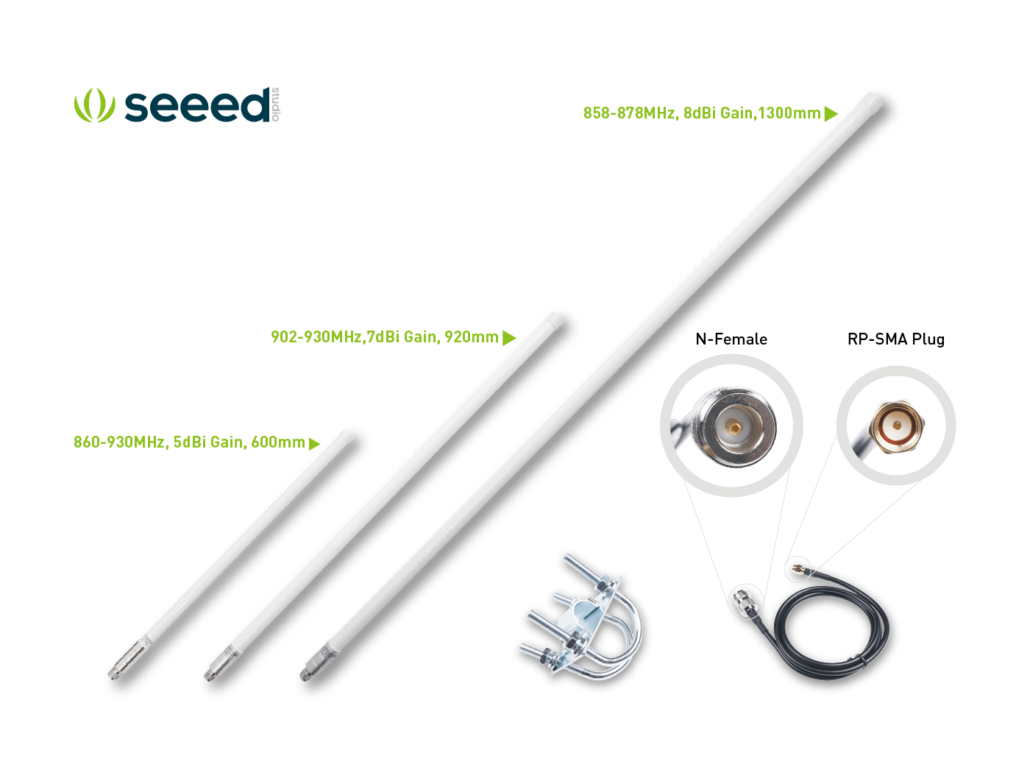
Product Features:
- Transmission Gain: 5.0 +/- 0.8 dBi @ 860~930 MHz
- Omnidirectional Radiation Pattern
- Excellent build quality to withstand harsh outdoor environments
- N-J Double tooth connector, N-Female to RP-SMA adapter included for easy interfacing with SenseCAP Gateways
- Includes hardware for mounting
Be sure to click here and visit the Seeed Online Store for the full range of options!
Note: The LoRa Fiberglass Antenna has an extremely high transmission efficacy, and may interfere with other critical wireless infrastructure in your region. Before using the antenna for any kind of application, please ensure that you are not in violation of any laws! For information that is specific to your country or region, please view this Frequency Plan by Country on The Things Network’s website.
Why use a Fiberglass Antenna?
Fiberglass is a type of plastic that has been reinforced using glass fibres. Since the material itself does not conduct electricity, fiberglass antennas still have a conductive element included within the antenna to transmit the radio signals. For example, in the case of Seeed’s LR Fiberglass Antenna, that conductive element is copper.
Where a fiberglass antenna truly shines is the enhancements to build quality as a result of the fiberglass material. Fiberglass has extremely high tensile strength, making it resistant to bending and breaking. Additionally, it has high vibration resistance, thermal insulation, electrical insulation, chemical resistance, water non-observant (does not absorb water) and is UV radiation insensitive, which makes it extremely suitable for operating in harsh outdoor conditions.
For this reason, fiberglass antennas are often used over traditional steel antennas for outdoor applications like moving trucks, since the rigidity of the material allows the antenna to stay upright even at highway speeds! This also allows the antennas to be mounted on the outside of such vehicles to reduce any losses in transmission range or quality.
Long Range Applications with LoRa
LR excels in long-range transmissions and is already being used in many industries to achieve IoT applications in numerous industries. With a LoRa antenna, we can surely take these applications to the next level – Here are some examples of applications that have been designed with LR and LoRaWAN with The Things Network (TTN)!
Smart Cities: Smart Bin Level Monitoring
When it comes to building greener, cleaner cities, most people often don’t think of smart waste bins. However, waste management is in fact a key area of development, especially if we want to improve the liveability of our cities even as human populations increase. This post on TTN suggests that we can use LoRaWAN-capable devices to monitor a waste bin’s fill level and other conditions, to notify bin management services when maintenance is required.
It shares that bin maintenance in typical cases refers to replacing bins when they are full. However, it may also comprise situations where there is too much moisture, heat, or smell. In this manner, bin maintenance will not only be more timely and effective; long term data can also be used to better understand waste disposal patterns and for infrastructure to be adjusted accordingly.
With hundreds or even up to thousands of bins in major cities around the world, LoRaWAN is the perfect candidate for connecting and collecting data from a vast number of edge devices spread across large areas!
Agriculture: Smart Poultry Farming
As a traditional industry, agriculture is comparatively less digitised than most other pillar industries. Despite this, did you know that environmental factors such as temperature, humidity, light and atmospheric composition play critical roles in poultry in farming? Because of this, LoRaWAN brings value to the equation with a network of environmental sensors to monitor farm conditions.
In fact, Kinghoo AgroTech is one of many companies who have chosen to utilise Seeed’s SenseCAP Wireless LoRaWAN sensors and modules to improve the effectiveness of their agricultural operations! To read more about this case study, read our full coverage here.
Agriculture: Natural Drying System in Post-Harvest Agriculture
The applications of LoRaWAN in agriculture do not lie strictly in farming only. In fact, the greatest loss in value of agricultural products occurs post-harvest. This project on Hackster aims specifically to use LR -enabled sensors and nodes to monitor the conditions in coffee bean drying houses to improve produce quality.
By connecting his LoRaWAN Gateway to TTN, Ahmad was able to also visualise data in real time. As the project is still a work in progress, he shares that there is also the possibility of performing machine learning on environmental data to predict microclimate conditions. This is truly a smart IoT solution enabled by LoRaWAN!
Supply Chain & Logistics: Vehicle & Driver Condition Tracking
With its long range capabilities, LoRaWAN holds great potential in supply chain and logistics where items of interest are transported across large distances. Thus, long-range wireless transmission is also extremely useful and important for such applications. For example, LoRaWAN is already seeing uses in asset tracking, fleet operation, preventive & predictive maintenance and theft prevention.
Once again, LoRaWAN is able to bring immense value when it comes to long range remote tracking of assets on a large scale, followed by the consolidation of information which allows for big data analytics and even machine learning. Ultimately, businesses can leverage LoRaWAN to reduce costs, optimise operations and make better decisions!
Getting Started with LoRa – Product Recommendations
At Seeed, we are committed to developing industrial-grade IoT products and solutions to help you meet any kind of industrial IoT needs. Seeed supports industrial transformations through hardware in our SenseCAP Series: SenseCAP Sensors, SenseCAP LoRaWAN Gateway; and a complete suite of supporting software like the SenseCAP Portal, SenseCAP App, SenseCAP API and SenseCAP Dashboard.
By building a vast LoRa network that is then connected to servers in the cloud, a diverse range of solutions can be developed for any business problem, regardless of the intended application in monitoring, control or maintenance!
Note: Before purchasing any of the following products, please ensure that you have selected the correct frequency band for your region! For more details, please once again visit this Frequency Plan by Country on The Things Network’s website.
SenseCAP LoRaWAN Gateway
A LoRaWAN Gateway is the bridge between your LR networks between your end nodes and the server in the cloud. It collects, aggregates and uploads data from your sensors in the field to the cloud for easy access and further action. The SenseCAP LoRaWAN Gateway is equipped with a high-performance processor AM3358 and the telecom-operator-level LR chip, SX1301 to ensure robustness and high performance in large-scale networks. In addition, it includes mutual authentication and encryption for added security!
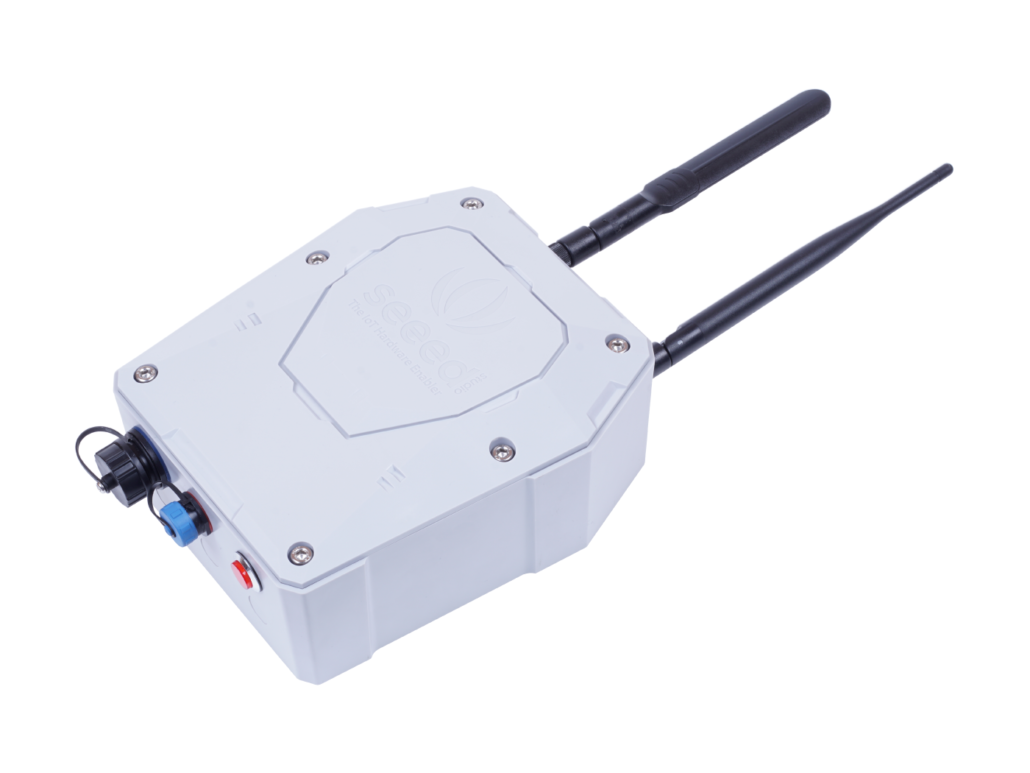
Product Features:
- High-performance Cortex A8 1GHz processor, Linux system.
- Supports LoRaWAN protocol Class A, support ultra-low-power SenseCAP Sensor
- 8 RX, 1 TX transceiver, maximum transmit power 27dBm
- Multiple ISM bands: CN470, EU868, US915
- Internet Access via 4G or Ethernet
- Ultra-long Distance Transmission: 10km with Line-of-Sight, 2km in Urban Environments
- Industrial grade protection: IP66 enclosure, temperature -40℃~70℃, suitable for outdoor applications
- Easy deployment and rapid provisioning
Visit the Seeed Online Store for more information on the SenseCAP LoRaWAN Gateway, as well as a quick tutorial on how to get started!
SenseCAP M2 Multi-Platform LoRaWAN Indoor Gateway
SenseCAP M2 Multi-Platform LoRaWAN Gateway is a standard LoRaWAN gateway that supports connecting to different network servers. It supports global LoRaWAN frequency plans from 865 MHz to 923 MHz and can be used in multiple LoRaWAN applications like smart building, environmental monitoring systems, precision farming, etc.
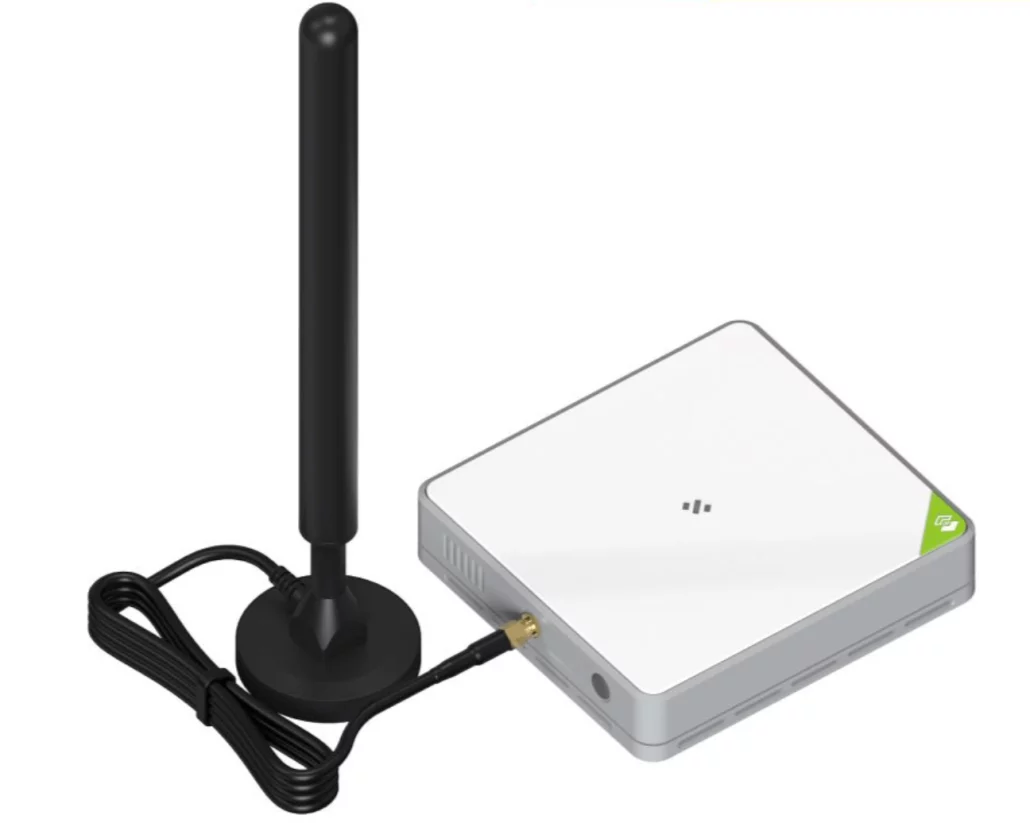
Product fearture
- Up to 10km of LoRaWAN® coverage and strong signal, allowing users to send data with extremely long ranges at low data rates.
- Compatible with multiple LNS like AWS, TTN, ChirpStack, etc. via using the Packet Forwarder / Basic Station mode.
- Based on Chirpstack, provides a fast and reliable solution for launching a LoRaWAN network.
- The PoE feature is also added to this device, making your deployment more reliable and faster.
- Supports Cellular(optional)、Wi-Fi and Ethernet for internet backhaul.
To learn more about the SenseCAP M2 Multi-Platform Indoor Gateway, click the product page on the Seeed Online Store.
Wio-E5 Development Kit
The Wio-E5 Development Kit consists of the Wio-E5 Development board, an antenna, a USB Type C Cable and a 2*AA 3V Battery Holder. The LoRa-E5 Dev Board is embedded with the LoRa-E5 STM32WLE5JC module with LoRaWAN protocol compatibility on the global frequency band. In addition, it supports various data protocols and interfaces, such as full GPIOs, RS-485 and Grove!
Product Features:
- Ultra-low power consumption and high performance
- Easy testing and rapid prototyping
- Full GPIOs that lead out to rich interfaces, including RS-485, Grove, and etc.
- Global LoRaWAN® and LR frequency plan supported
- Long-distance transmission range to 10km (ideal value in open area)
If you’re keen to pick up the Wio-E5 Development Kit, visit the Seeed Online Store now!
The Wio E5 Development Board is part of the Wio E5 Series, which is built around the Wio E5 STM32WLE5JC module that has been designed with an ARM Cortex-M4 core and the SX126x LR module. You can also choose from a mini Dev Board, Grove module, or order the WioE5 module itself for your custom designs!
Tutorial: Using LoRa with Arduino & Raspberry Pi!
Getting into the world of LR & LoRaWAN can be daunting, but experimenting with a low cost Arduino microcontroller or Raspberry Pi Single Board Computer is often a great way to get your feet wet. Visit this previous article for a step-by-step detailed guide on how to build your very own LoRaWAN network!
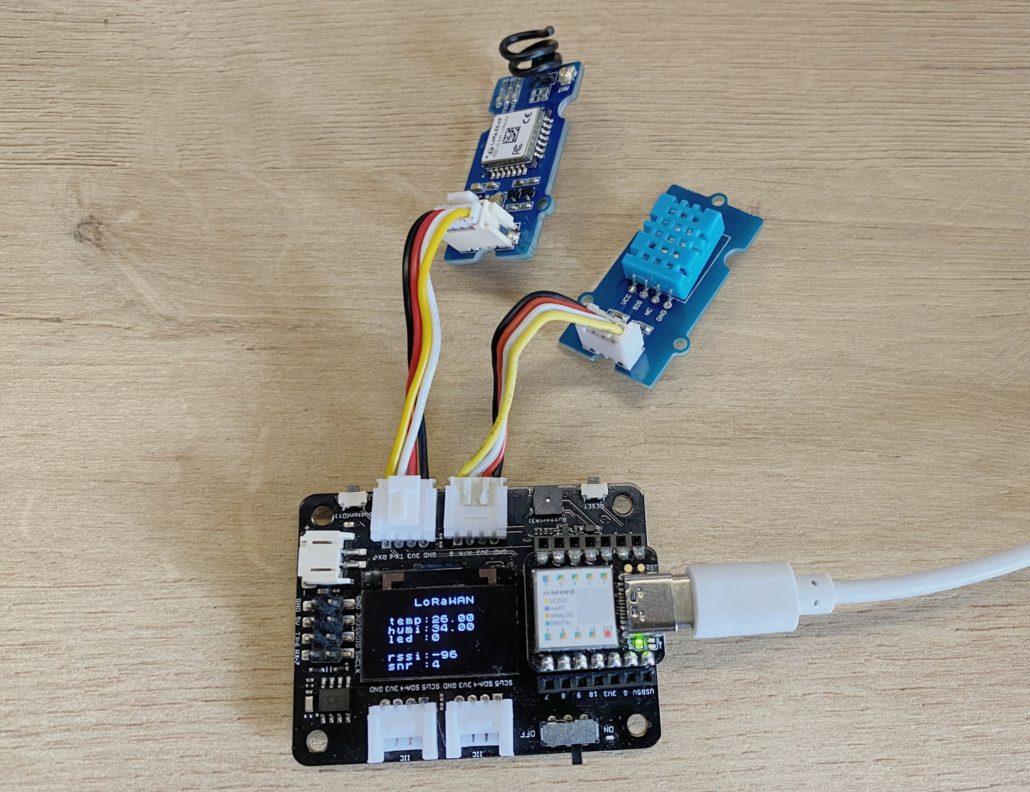
Summary & More Resources
To summarise, LR communication is a powerful technology, and LoRaWAN networks great for long-range and large-scale IoT applications. Using an LR antenna is just one simple way of bringing out more from your existing hardware! In other cases, the enhanced robustness and build quality from a fiberglass antenna might be a necessity, depending on where you are deploying your LR system!
To learn more, you might want to visit some of our previous articles!
- What is Peer-To-Peer (P2P) LoRa Communication?
- IoT in Smart Agriculture: LPWAN Technologies & Applications
- How to Enable LR and LoRaWAN on Arduino and Raspberry Pi
- How Machine Learning has Transformed Industrial IoT